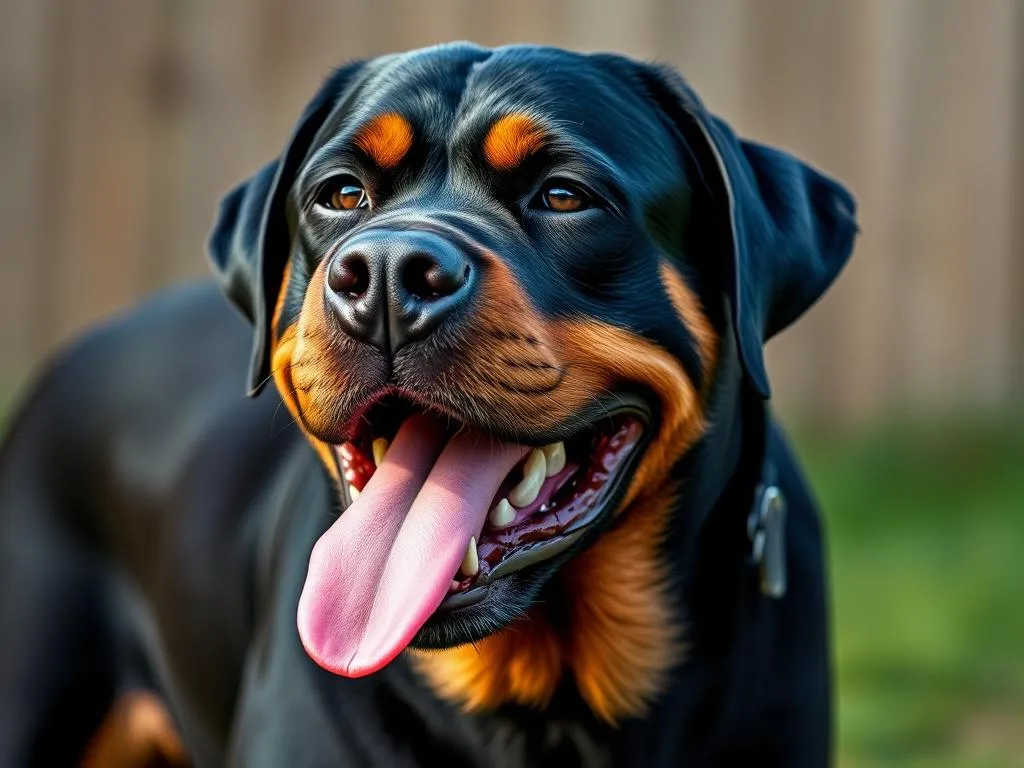
Introduction
Understanding your dog’s behavior is crucial for developing a strong and harmonious relationship. One breed that often raises questions about its vocalizations is the Rottweiler. In this article, we will explore the specific question: do Rottweilers growl when happy? We’ll delve into the various aspects of Rottweiler behavior, particularly focusing on growling tendencies, and provide insights that can help Rottweiler owners better interpret their dogs’ vocalizations.
Rottweilers are known for their loyalty, strength, and protective nature. However, they also possess a playful side that can sometimes be misinterpreted, especially when it comes to growling. By understanding the nuances of dog behavior, particularly in Rottweilers, owners can navigate their interactions more effectively.
Understanding Growling in Dogs
What is Growling?
Growling is a vocalization that dogs use to communicate various emotions. It can range from a low rumble to a more pronounced sound, depending on the context and the dog’s emotional state. While many people associate growling with aggression, it is essential to understand that it serves multiple purposes in a dog’s communication toolkit.
Types of Growling
Growling can be categorized into several types:
- Playful Growling: Often accompanied by a wagging tail and relaxed body posture, this growl indicates excitement and can be a part of playtime.
- Warning Growling: A more serious sound that may accompany defensive body language, warning growling signals discomfort or a desire to protect territory or resources.
- Aggressive Growling: This growl is typically deep and accompanied by a tense body posture, indicating that the dog feels threatened or is ready to defend itself.
Context of Growling
The context in which a dog growls is crucial for interpretation. For instance, a growl during playtime can signal joy, while a growl during a confrontation can indicate discomfort or aggression. Understanding the situation will help owners respond appropriately.
Rottweilers and Their Behavior
Overview of Rottweiler Temperament
Rottweilers are known for their confident, courageous, and loyal nature. They are often described as protective and intelligent, making them excellent companions and working dogs. However, their strong personalities also require responsible ownership and proper training.
Common Behaviors in Rottweilers
Rottweilers exhibit a range of behaviors that can include:
- Playfulness: They enjoy interactive games and often display their excitement through vocalizations, including growling.
- Loyalty: Rottweilers form strong bonds with their families and can be protective of their loved ones.
- Protectiveness: This breed is naturally protective, which can manifest in vocalizations when they perceive a threat.
- Social Tendencies: While they can be wary of strangers, Rottweilers can also be sociable and affectionate with those they know.
Rottweiler Body Language
Understanding body language is essential for interpreting growling. Signs to look for include:
- A wagging tail can indicate happiness, especially when combined with playful growling.
- Ears positioned forward generally indicate curiosity or excitement.
- A relaxed body posture, with loose muscles, suggests a happy state, while a tense posture may indicate discomfort.
Do Rottweilers Growl When Happy?
Evidence and Observations
Many Rottweiler owners and trainers have observed that Rottweilers do growl when happy, especially during play or moments of affection. This growl can be a form of communication that expresses their excitement and enjoyment. Anecdotal evidence from numerous owners highlights instances where playful growling accompanies games of fetch or tug-of-war.
Situations Where Rottweilers May Growl Happily
Rottweilers may growl happily in various situations, such as:
- During Play: In a game of fetch or tug-of-war, a Rottweiler may growl as a way to express excitement and engagement.
- When Being Petted: Many Rottweilers will emit a low growl while being petted, indicating contentment and enjoyment.
- Socializing: When interacting with familiar dogs or people, a Rottweiler may growl in a playful manner to initiate or continue the interaction.
Differentiating Happy Growls from Other Growls
To differentiate a happy growl from other types, owners should look for the following indicators:
- Body Language: Happy growls are typically accompanied by a relaxed body, wagging tail, and playful demeanor.
- Tone and Pitch: Happy growls may sound higher-pitched or softer than warning or aggressive growls.
- Context: Situational awareness is key. If the growling occurs during play or affectionate moments, it is likely a happy growl.
Factors Influencing Growling Behavior
Genetics and Breed Specific Traits
Genetics play a significant role in a dog’s behavior. Rottweilers, as a breed, may have inherited traits that influence their vocalizations. Understanding these genetic predispositions can help owners anticipate and interpret their dogs’ behaviors more accurately.
Socialization and Training
The importance of early socialization cannot be overstated. Rottweilers that are well-socialized from a young age are more likely to display positive behaviors, including appropriate growling during play. Training can also shape their responses, teaching them when growling is acceptable and when it may be inappropriate.
Environment and Contextual Factors
The environment in which a Rottweiler is raised and lives can significantly influence its behavior. Factors such as noise levels, the presence of other animals, and the general atmosphere can affect how a Rottweiler expresses itself. A calm and secure environment can encourage positive vocalizations, including happy growls.
Addressing Growling Behavior
When Growling is a Concern
While growling can be a normal part of a dog’s communication, there are times when it may be concerning. Signs that indicate growling may be a behavioral issue include:
- Persistent growling in situations that do not warrant it.
- Growling accompanied by aggressive body language or posturing.
- Growling directed towards family members or familiar pets.
Positive Reinforcement Training
To encourage positive growling behavior, owners can implement positive reinforcement techniques. This can include:
- Rewarding calm behavior with treats or praise, reinforcing the idea that growling is only appropriate in specific contexts.
- Redirecting undesirable growling by engaging the dog in play or providing distractions.
- Using commands and cues to help the dog understand when growling is acceptable.
Consulting a Professional
If growling becomes a concern, it’s essential to consult a professional. A veterinarian or dog behaviorist can provide guidance tailored to the individual dog’s needs and help address any underlying behavioral issues. Early intervention can prevent potential problems and promote a healthy relationship between the dog and its owner.
Conclusion
In summary, Rottweilers do growl when happy, and understanding this aspect of their behavior is vital for fostering a strong bond. By recognizing the different types of growling, the context in which they occur, and the unique characteristics of Rottweilers, owners can better interpret and respond to their dogs’ vocalizations.
Understanding dog behavior is crucial for all pet owners, as it enhances the owner-dog relationship and promotes responsible dog ownership. Observing and understanding your Rottweiler’s behavior can lead to a more fulfilling and enjoyable companionship. As with any breed, taking the time to learn about your Rottweiler’s unique traits and behaviors will ultimately lead to a happier and healthier relationship.
By embracing the joys of Rottweiler ownership and being attentive to their needs and communications, owners can ensure that their dogs thrive in a loving and understanding environment.
